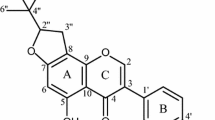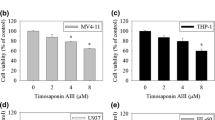Abstract
Hinesol is a unique sesquiterpenoid isolated from the Chinese traditional medicine, Atractylodes lancea rhizome. In a previous study, we screened various natural products in human leukemia HL-60 cells and identified an essential oil fraction from A. lancea rhizome that exhibited apoptosis-inducing activity in these cells; hinesol was subsequently shown to be the compound responsible for this apoptosis-inducing activity. In this study, we describe the cytotoxic effects and molecular mechanisms of hinesol in HL-60 cells. The antitumor effect of hinesol was associated with apoptosis. When HL-60 cells were treated with hinesol, characteristic features of apoptosis, such as nuclear fragmentation and DNA fragmentation, were observed. These growth-inhibitory and apoptosis-inducing activities of hinesol in leukemia cells were much stronger than those of β-eudesmol, another compound isolated from the essential oil fraction. Furthermore, hinesol induced activation of c-Jun N-terminal kinase (JNK), but not p38, prior to the onset of apoptosis. These results suggested that hinesol induced apoptosis through the JNK signaling pathway in HL-60 cells. Therefore, hinesol may represent a novel medicinal drug having indications in the treatment of various cancers, including leukemia.






Similar content being viewed by others
References
Wyllie AH, Morris RG, Smith AL, Dunlop D (1984) Chromatin cleavage in apoptosis: association with condensed chromatin morphology and dependence on macromolecular synthesis. J Pathol 142:67–77
Laurent-Crawford AG, Krust B, Muller S, Riviere Y, Rey-Cuille MA, Bechet JM, Montagnier L, Hovanessian AG (1991) The cytopathic effect of HIV is associated with apoptosis. Virology 185:829–839
Ucker DS (1987) Cytotoxic T lymphocytes and glucocorticoids activate an endogenous suicide process in target cells. Nature 327:62–64
Hurle JM, Lafarga M, Hinchliffe JR (1981) The surface coat of embryonic limb mesenchymal cells during morphogenetic cell death. Exp Cell Res 133:465–470
Kaufmann SH (1989) Induction of endonucleolytic DNA cleavage in human acute myelogenous leukemia cells by etoposide, camptothecin, and other cytotoxic anticancer drugs: a cautionary note. Cancer Res 49:5870–5878
Friesen C, Herr I, Krammer PH, Debatin KM (1996) Involvement of the CD95 (APO-1/FAS) receptor/ligand system in drug-induced apoptosis in leukemia cells. Nat Med 2:574–577
Bhalla K, Ibrado AM, Tourkina E, Tang C, Mahoney ME, Huang Y (1993) Taxol induces internucleosomal DNA fragmentation associated with programmed cell death in human myeloid leukemia cells. Leukemia 7:563–568
Watabe M, Masuda Y, Nakajo S, Yoshida T, Kuroiwa Y, Nakaya K (1996) The cooperative interaction of two different signaling pathways in response to bufalin induces apoptosis in human leukemia U937 cells. J Biol Chem 271:14067–14072
Masuda Y, Shima G, Aiuchi T, Horie M, Hori K, Nakajo S, Kajimoto S, Shibayama-Imazu T, Nakaya K (2004) Involvement of tumor necrosis factor receptor-associated protein 1 (TRAP1) in apoptosis induced by beta-hydroxyisovalerylshikonin. J Biol Chem 279:42503–42515
Kajimoto S, Takanashi N, Kajimoto T, Xu M, Cao J, Masuda Y, Aiuchi T, Nakajo S, Ida Y, Nakaya K (2002) Sophoranone, extracted from a traditional Chinese medicine Shan Dou Gen, induces apoptosis in human leukemia U937 cells via formation of reactive oxygen species and opening of mitochondrial permeability transition pores. Int J Cancer 99:879–890
Masuda Y, Nishida A, Hori K, Hirabayashi T, Kajimoto S, Nakajo S, Kondo T, Asaka M, Nakaya K (2003) Beta-hydroxyisovalerylshikonin induces apoptosis in human leukemia cells by inhibiting the activity of a polo-like kinase 1 (PLK1). Oncogene 22:1012–1023
Derijard B, Hibi M, Wu IH, Barrett T, Su B, Deng T, Karin M, Davis RJ (1994) JNK1: a protein kinase stimulated by UV light and Ha-Ras that binds and phosphorylates the c-Jun activation domain. Cell 76:1025–1037
Galcheva-Gargova Z, Derijard B, Wu IH, Davis RJ (1994) An osmosensing signal transduction pathway in mammalian cells. Science 265:806–808
Sanchez-Perez I, Murguia JR, Perona R (1998) Cisplatin induces a persistent activation of JNK that is related to cell death. Oncogene 16:533–540
Chen YR, Wang X, Templeton D, Davis RJ, Tan TH (1996) The role of c-Jun N-terminal kinase (JNK) in apoptosis induced by ultraviolet C and gamma radiation. Duration of JNK activation may determine cell death and proliferation. J Biol Chem 271:31929–31936
Kitajima J, Kamoshita A, Ishikawa T, Takano A, Fukuda T, Isoda S, Ida Y (2003) Glycosides of Atractylodes lancea. Chem Pharm Bull (Tokyo) 51:673–678
Buhagiar JA, Podesta MT, Wilson AP, Micallef MJ, Ali S (1999) The induction of apoptosis in human melanoma, breast and ovarian cancer cell lines using an essential oil extract from the conifer Tetraclinis articulata. Anticancer Res 19:5435–5443
Paik SY, Koh KH, Beak SM, Paek SH, Kim JA (2005) The essential oils from Zanthoxylum schinifolium pericarp induce apoptosis of HepG2 human hepatoma cells through increased production of reactive oxygen species. Biol Pharm Bull 28:802–807
Scudiero DA, Shoemaker RH, Paull KD, Monks A, Tierney S, Nofziger TH, Currens MJ, Seniff D, Boyd MR (1988) Evaluation of a soluble tetrazolium/formazan assay for cell growth and drug sensitivity in culture using human and other tumor cell lines. Cancer Res 48:4827–4833
Kiso Y, Tohkin M, Hikino H (1983) Antihepatotoxic principles of Atractylodes rhizomes. J Nat Prod 46:651–654
Xia Z, Dickens M, Raingeaud J, Davis RJ, Greenberg ME (1995) Opposing effects of ERK and JNK-p38 MAP kinases on apoptosis. Science 270:1326–1331
Seo MJ, Kim SJ, Kang TH, Rim HK, Jeong HJ, Um JY, Hong SH, Kim HM (2011) The regulatory mechanism of beta-eudesmol is through the suppression of caspase-1 activation in mast cell-mediated inflammatory response. Immunopharmacol Immunotoxicol 33:178–185
Kimura Y, Sumiyoshi M (2012) Effects of an Atractylodes lancea rhizome extract and a volatile component beta-eudesmol on gastrointestinal motility in mice. J Ethnopharmacol 141:530–536
Cragg GM, Newman DJ (2005) Plants as a source of anti-cancer agents. J Ethnopharmacol 100:72–79
Li Y, Li T, Miao C, Li J, Xiao W, Ma E (2013) β-Eudesmol induces JNK-dependent apoptosis through the mitochondrial pathway in HL60 cells. Phytother Res 27:338–343
Zhang L, Nakaya K, Yoshida T, Kuroiwa Y (1992) Induction by bufalin of differentiation of human leukemia cells HL60, U937, and ML1 toward macrophage/monocyte-like cells and its potent synergistic effect on the differentiation of human leukemia cells in combination with other inducers. Cancer Res 52:4634–4641
Satoh K, Nagai F, Kano I (2000) Inhibition of H + , K + -ATPase by hinesol, a major component of So-jutsu, by interaction with enzyme in the E1 state. Biochem Pharmacol 59:881–886
Davis RJ (2000) Signal transduction by the JNK group of MAP kinases. Cell 103:239–252
Masuda Y, Nakaya M, Aiuchi T, Hashimoto S, Nakajo S, Nakaya K (2000) The mechanism of geranylgeraniol-induced apoptosis involves activation, by a caspase-3-like protease, of a c-jun N-terminal kinase signaling cascade and differs from mechanisms of apoptosis induced by conventional chemotherapeutic drugs. Leuk Res 24:937–950
Acknowledgments
This work was supported in part by Grants-in-Aid from the Ministry of Education, Culture, Sports, Science, and Technology of the Japanese Government. The authors would also like to thank all of the researchers who were involved in the research.
Conflict of interest
None declared.
Author information
Authors and Affiliations
Corresponding author
Rights and permissions
About this article
Cite this article
Masuda, Y., Kadokura, T., Ishii, M. et al. Hinesol, a compound isolated from the essential oils of Atractylodes lancea rhizome, inhibits cell growth and induces apoptosis in human leukemia HL-60 cells. J Nat Med 69, 332–339 (2015). https://doi.org/10.1007/s11418-015-0897-5
Received:
Accepted:
Published:
Issue Date:
DOI: https://doi.org/10.1007/s11418-015-0897-5




